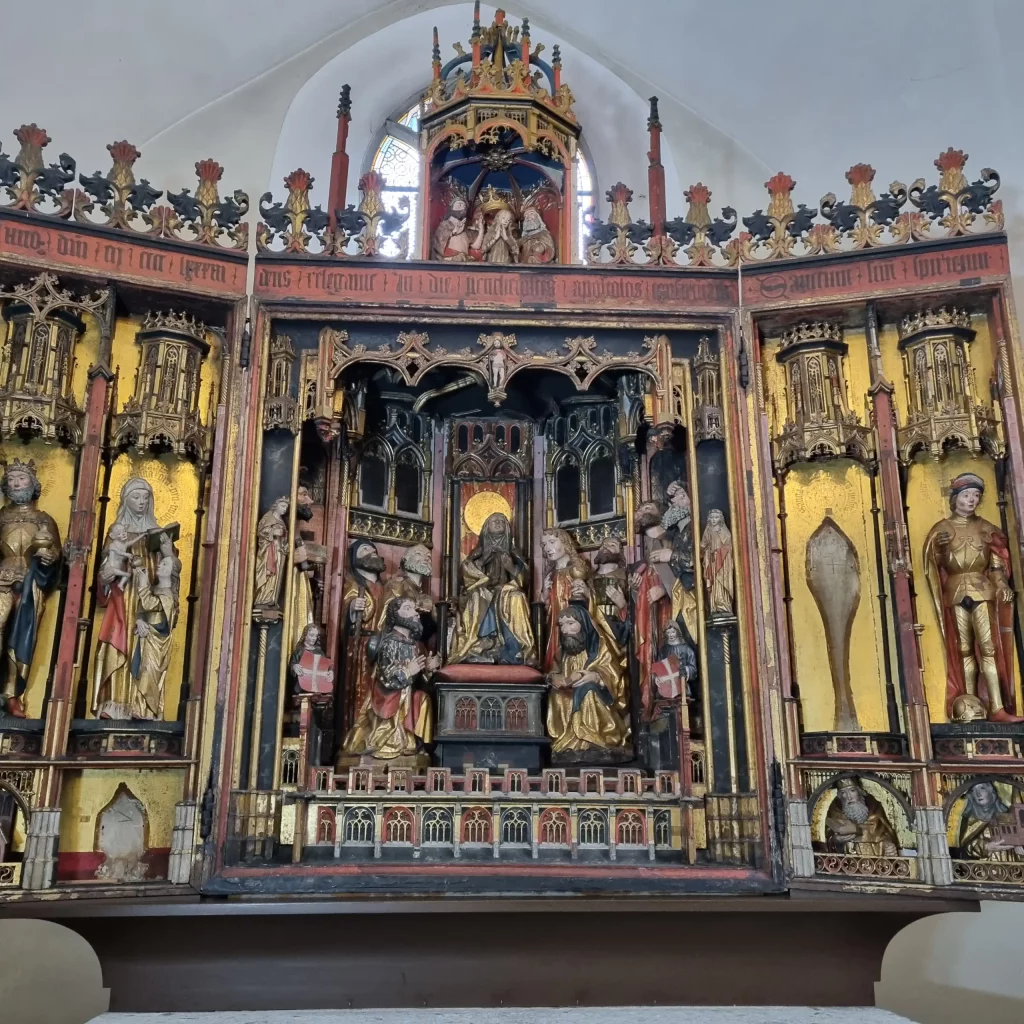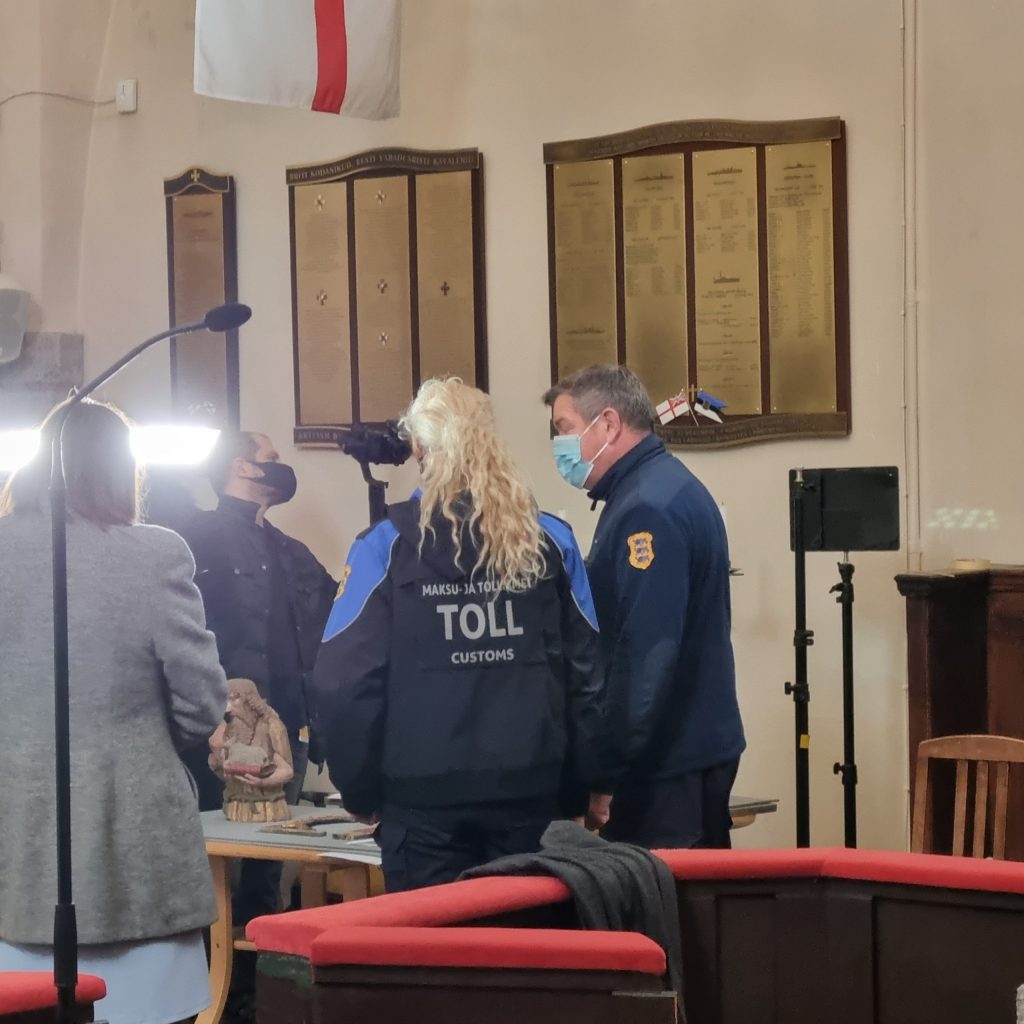Technical examinations have continuously been conducted on the altarpiece since the time when conservators from Moscow worked on the retable. Data has also been published in various articles and books, but information therein is fragmentary and primary source materials are often not available from the archives (Moltke, E. 1970). For this reason, it was decided to conduct large-scale technical examinations that require access to the retable’s details, which emerge only in the course of the conservation work, in parallel with the current conservation project.
The grand kick-off for these technical examinations took place in September of 2021 in the form of a week-long workshop. Dozens of people – ranging from students to specialists, from enthusiasts to researchers – participated in seminars, lectures, material examinations, and other such undertakings. The main focus was on five sculptures: St. Philip, St. John the Baptist, St. Elisabeth, the so-called Donator (photo 1), and the Virgin Mary, who was taken out of the retable to enable better access (photo 2). Additionally, the paintings on the retable’s wings were under scrutiny, and partial examinations were conducted on them.


X-ray examinations, which made it possible to take a look ‘inside’ the sculptures, were conducted together with Estonian Tax and Customs Board specialists (photo 3) – to study their structure, the mechanisms for affixing them, and later repairs. In addition to x-rays taken on site, we succeeded in transporting the figure of the Virgin Mary to the Estonian Forensic Science Institute thanks to the removal of that statue from the altarpiece. At the Institute, experiments were conducted for the first time in Estonia to x-ray medieval wooden sculptures using computer tomography. The result was an excellent three-dimensional x-ray image by which the metal elements within the sculpture, the distinctive features of the figure, and also the use of pigments containing metals on the sculpture’s surface became discernible (photo 4).


Eamination of paint layers and determination of pigments, conducted in cooperation with the Estonian Centre for Environmental Studies and the Institute of Analytical Chemistry, University of Tartu, provided preliminary knowledge of materials used in the original work and in later restoration layers. Two layers of overpainting emerged in many places, which evidently correspond to the refurbishments of the altarpiece from 1625 and 1815 that are known from the sources. Based on analyses of the pigments, it can be conjectured that some rather extensive painting repairs could date from the latter half of the 19th century or the early 20th century (the possible use of zinc white indicated this dating), quite likely from the time when the retable was located at St. Nicholas’ Church.
The examination of the elemental composition of the original paint raised several questions, which are of interest in the context of international research. For instance, the layered structure of the various colour tones – e. g. vermilion in the case of red, which may be coated with some sort of organic material (with madder lake, for instance); dark underpainting in the case of blue azurite. The structure of the green paint is very distinctive in the case of St. Philip – earlier researchers have also identified this (Birstein, V. J., Naumova, M. M., Tul’chinsky, V. M. 1978.). The marbled surface on the concave framing of the central shrine, which currently looks almost black but was originally azure blue, is also very rarely found.
The extent to which the polychromy of the central sculpture group differs from that of the sculptures of the wings and the tabernacle remains to be determined. A few references have emerged in this examination indicating that the polychromy of the central statues is somewhat more complex, perhaps even more costly, than that of the wings. Previous examinations have ascribed the sculptures of Tallinn’s retable to two different woodcarvers (Petermann, K. 2000). In the future, we will be able to check whether this difference also emerges in regard to the polychromy of the sculptures.At this stage of research it appears that a protein-based binding medium prevails in the original polychromy. Future research should indicate the extent to which the medieval custom of using different binders with different pigments to achieve various desired surface effects in a single polychromatic object is traceable in the case of Tallinn’s retable.
Bibliopgraphy
- Moltke, E. 1970. Bernt Notkes altertavle i Århus domkirke og Tallinntavlen: mit Regesten und Bildtexten auf deutsch. (Vol. 1–2). København; Bregmann, N., Lelekova, O. 1976. Die Restaurierung des Altars von Bernt Notke in Tallinn. // Internationales Kolloquium zum Werk des Bernt Notke: Anlässlich der Restaurierung der Triumphkreuzgruppe im Dom Lübeck 22.–24. September 1976 (Vorträge). Lübeck. Pp. 126–133; Birstein, V. J., Naumova, M. M., Tul’chinsky, V. M. 1978. An Examination of Some Painting Materials of Several 15th Century Polychrome Sculptures. // ICOM Committee for Conservation 5th Triennial Meeting, Zagreb, Yugoslavia 1.–8. X 1978; Наумова, М. М., Бирштейн, В. Я., Тульчинский, В. М. 1981. Исследование некоторых материалов живописи полихромных росписей деревянных скульптур 15 века [Investigation of some materials used in polychrome wooden sculptures of the 15th century]. // Художественное наследие. 7 (37). Pp. 52–58; Kanut Conservation and Digitisation Centre. 2009. Tallinna Püha Vaimu kappaltari tabernaakli konserveerimistööde aruanne [The conservation report of the tabernacle of the altarpiece of the Church of the Holy Spirit, Tallinn]. Compiled by P. Ehasalu, K. Sibul, I. Pihelgas, S. Vahur, V. Talimaa; Ehasalu, P. 2010. Tallinna Püha Vaimu kiriku kappaltari tabernaakli uurimine ja konserveerimine: pilootprojekt altari seisundi ja konserveerimisvajaduse hindamiseks [The investigation and conservation of the tabernacle of the altarpiece of the Church of the Holy Spirit, Tallinn: a pilot project for the evaluation of the state of preservation and conservation needs of the altarpiece]. // Renovatum Anno 2010. Pp. 64−74.
- Birstein, V. J., Naumova, M. M., Tul’chinsky, V. M. 1978. An Examination of Some Painting Materials of Several 15th Century Polychrome Sculptures. // ICOM Committee for Conservation 5th Triennial Meeting, Zagreb, Yugoslavia 1.–8. X 1978.
- Petermann, K. 2000. Bernt Notke. Arbeitsweise und Werkstattorganisation im späten Mittelalter. Berlin: Reimer. Pp. 108–111